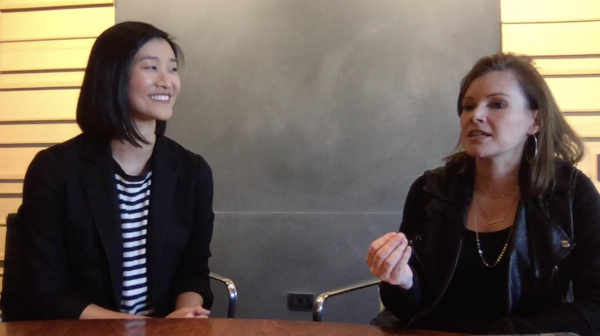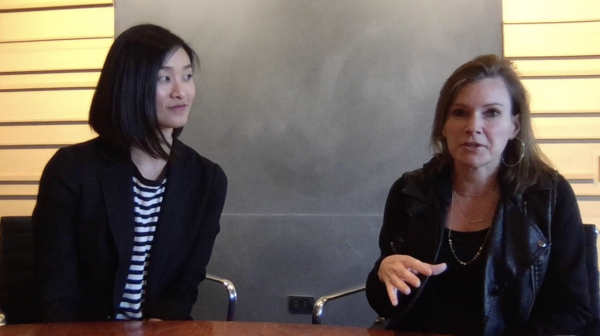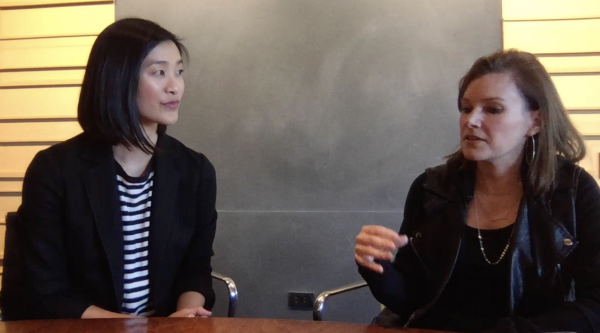As the CEO of Jellyvision, a 400-person software company, Amanda Lannert has won just about every “best CEO” award in Chicago, and is someone I’ve admired for years.
In this 12 minute interview, Amanda admits the one lesson she wishes she learned earlier as a leader. Watch or listen to the full interview…
Claire: Hi, everyone! I’m Claire Lew, [CEO of Know Your Company,] and I am incredibly excited to have one of my heroes here today. I have with me Amanda Lannert, who is the CEO of Jellyvision, a software company here in Chicago. Amanda and I have known each other for I feel like a good amount of time.
Amanda: It feels like it’s been a long time — like we’ve been through a lot together. I feel like just when you started, I met you before, so it’s been many iterations. So even if it hasn’t been like 10 years, it’s been a lot of life, passing through time.
Claire: Yes. You’ve seen me through it all.
Amanda: Yes.
Claire: And there have been plenty of times I have come to Amanda in moments of crisis, in moments of big decisions…
Amanda: Of growth, expansion, world domination…
Claire: Haha yes, thank you. And so it’s only fitting that I have Amanda here today to ask her this one question I’ve been asking a lot of leaders, which is:
“What’s one thing, or several things, if you feel like it, that you wish you would’ve learned earlier as a leader?”

Amanda: So I knew the question in advance, which in fact for me makes it harder, not easier, because then you get to agonize over all the possible things you can say. And so I did what I often do, which is I sat down with some trusted counsel at Jellyvision, and I said, “What’s the one thing that I wish I had learned earlier in my career?” And started talking about the many lessons I repeatedly talk about.
But the one I wish I had learned, and I say over and over that I wish I had remembered, is to trust my gut when it comes to hiring and staffing and promoting and believing in people. There’s such temptation at all stages of conquering newness to lean on the resume, to lean on the sense of history rather than to take the leap of faith on the potential or a DNA. And every single one of my big hiring mistakes, every single one of the painful non-fits has been where I weighted the resume, the past perspective over the DNA, the future potential perspective.
And the reason why I think that that’s so important is your history is what you have done, and what I want to know is what can you do in circumstances that certainly will never be exactly what you’ve done before.
To me, being an adaptive self-learner, a figure-it-outer, is more important than saying “I’ve had these 10 or 15 really special experiences,” because technology changes, business changes, political climates change, people change, and it’s all about how can you deal with the new, versus really ever expecting someone to sort of crank through and iterate and do the same thing over and over.
So getting back to the one thing that I wish I had learned earlier and wish I had held myself accountable to once I had learned it, is going with my gut and trusting the potential rather than documented history when it comes to placing people in positions of influence.
Claire: That’s hard. It’s easier said than done.
Amanda: Specially when it’s new, specially when it’s higher-stakes.
Claire: Yes.

Amanda: Especially when you’ve got a lot of people trusting in you and counting on you to get it right.
But again and again and again, I mean, Jellyvision is run by a lot of first-timers, and my career is based on people giving chances to first-timers.
I mean, my whole career is the lucky break — the lucky break. And it’s amazing what people can do with the will and the ability to sit down and try to figure stuff out.
The Google’s pretty awesome in terms of providing information.
So that to me’s the one thing I wanted to talk about.
Claire: I’m so glad that you did, because I think the “box” that is hiring, that everyone feels like, “Oh, I’m trying to figure out what’s in the box. I’m trying to figure out exactly how do I find that great, amazing person who’s just going to change our team dynamic.” Everyone has, “Oh, yeah, do this, do this, do this,” and I think it becomes so easy and so tempting to rely on just, “Oh, yeah, the resumé. This is what people have done.” And I think even some people might argue and say, “Well, Amanda, isn’t what people have done … isn’t that the only thing you can judge them on?”
How do you even measure potential? What are you looking at? When you talk to me about that, are you saying like just a feeling? How do you actually identify what that potential is?
Amanda: So I do a lot of backwards-looking interviewing, for sure. Talk to me about what your goals were here. What was hard; what were you proud of; what went well. A lot of past-looking stuff. But then I also like to ask present-tense case study type questions.
Claire: Okay.
Amanda: And we also have a component of auditioning, where everyone at Jellyvision has to go through a process of not just talking about your talent, but actually showing it. It’s not exactly consulting. It’s removed and redacted, but it still gives you a sense of the work and gives us a sense of how you work, which I think is incredibly valuable, to get a sense of not just what have you talked about.
Because in the past, you could have been an incredible contributor on a terrible team. Or you could have been the dead weight on a high-performing team, and it’s really hard to tell when you’re just looking at the resumé.
So we like to give people a chance to show their work, and also show the humility that goes with showing your work, which is self-selecting. A lot of people will self-select out. But giving the people a chance to show work is a great way to talk about what would you do, the hypotheticals — and it let’s me see people’s work instincts.
Perhaps it can be said that those interviews are better suited for extroverts than introverts.
Claire: Interesting.

Amanda: Or for people who like to think on their feet versus people who are more analytical and like a little bit of time to think it through. So we try to adjust and adapt, and allow for space for thinking. But I will in every interview ask a question or two that’s like, “How would you handle this?” And it’s something you hopefully wouldn’t have seen coming.
Claire: Right. In terms of, perhaps, outside pressures that you might get, whether it’s from … I don’t know if you do hiring committees, or maybe other members of your leadership staff. I mean, it sounds like you’ve made decisions where you’ve gone against your gut, right? What were the pressures that you were susceptible to in those moments that you wish you’d been like, “I should have listened to that!”
Was it yourself, was it outside pressure? Was it pressure in terms of company growth, or where you wanted to be? What advice do you have for folks who might be feeling similar pressures?
Amanda: So I think it is important to realize companies as they grow, they change. And used to have direct reporting relationships, and now you’re hiring someone who works for you as a CEO, but also people work with them. And so it’s many layers of sandwiches …
Claire: Yes!
Amanda: … where people who are very important and their reporting chain might have very different needs and different perspectives, and you have to balance accommodating for a fit with the reporting structure, but also creating a really tight, cohesive fit with an executive team.
Claire: Right.
Amanda: And a lot of times teams get their own culture, and they’re quite different, and quite unique.
So I think that it’s finding a balance act, of not subverting your style, your work style, your team style at the expense of accommodating another team, but really trying to find a balance so it’s not all on either side.
Claire: Right.
Amanda: And when you have high stakes, when you have 400 people counting on you …
Claire: I was just about to say …
Amanda: … to pay their bills and to be incredibly respectful of the time and trust that they’re giving you, you don’t want to fail. You don’t want to let them down. You don’t want to take longer to get to the finish line than your personal record. All of those things contribute to how can you mitigate risk. Great-looking resume’s kind of the pat answer for a way to mitigate risk. It’s tough to place a bet on a barely 30-year-old VP of sales. And that’s what Jellyvision did, and boy is it bearing fruit! But you’re sitting in that moment, and it’s like, “Oh, I hope this crazy call works!”
Claire: Yeah.
Amanda: And it’s really amazing when it does, but it feels like a riskier decision than working with someone who perhaps has 20 years of mentionable experience and track record.
Claire: Absolutely. I mean, I think it’s so difficult, again, just like you were saying, when the stakes are high.
So I’m gonna flip the question, or my next question just a little bit, for maybe for your aspiring leaders, maybe you’re in between jobs right now looking for that next opportunity. And they see, “Oh, wow! Jellyvision’s hiring for this VP of sales position. Maybe I haven’t had the track record that they ideally would like to see.”
To folks who may be in that position, where they’re looking for that opportunity; they know they don’t have the track record. What do you suggest to them to show people like you, CEOs of companies with 400-plus people, right? Growing, extremely successful. What do you say to them where they think … where you think, “Okay, this person, they’ve got it.”
Amanda: Yeah. Here’s what I would say to you if you want a job at Jellyvision:
Don’t be boring! It feels like companies hire people, but in fact people hire people.
And the people hiring people are looking for one person to stand out and say, “I am gonna contribute. I am gonna be a pleasure to work with. I’m gonna be no drama. I’m gonna have integrity.” And there’s nothing more refreshing than seeing someone who takes a chance to be incredibly human in a cover letter or an outreach, to put themselves forward.
The standard boring resume … it’s like you can’t tell who you’re gonna spend the vast majority of your waking hours with. So to me, I’d always say remember: It is people connecting with people. You are in no small part doing an ad about yourself, which feels really weird, I imagine, to many, but this is the chance to tell you what makes you tick. Things like, “I work hard. I have integrity. I’m eager to learn. And I bring baked goods to the office once a week.” I mean, that’s the kind of stuff that people are like, “That is someone I want to work with.”

So put not just your skills and experience, but put yourself into your letter, and don’t be afraid to not be boring. Because by and large recruiters are bored. People play it safe. They commoditize themselves into just a bullet-point list of skills and experience, and that’s just not what it’s about. It’s about people and how they interact and what they value and what they won’t tolerate, and trying to find people who will amplify your cultural values.
So take a risk and tell your story, and be honest about what you’re looking for and how you like to work, because funny enough, if you don’t get a call back, they may be saving you a lot of time and pain. So two-way fit’s really important. So the better you know who you are, and can tell that story, the more likely you are to find a fit with a company who really values it, values you.
Claire: I think that’s invaluable advice. That’s incredible. Yeah. Don’t be boring.
Amanda: It’s much more fun as a recruiter. You’re like, “Ah, this is interesting!”
Claire: Right.
Amanda: “We need to talk to this person!”
Claire: And it seems so obvious: “people are hiring people, not companies.” But it’s so true. I mean, you get thousands of applications, I’m sure, for a single position.
Amanda: We do. There are some of them it’s just … it’s a deluge. So we do say, “Thank you for standing out. Thank you for jumping out of the paper.” Cause all we’re looking for is the one or two or. It can be up to 20 people, depending on the role. But we are looking for those people, and you are looking for a home that will respect and value you. So let’s be honest.
Claire: Yep.
Amanda: And that’s the best way to find a two-way fit.
Claire: No, I think it’s amazing. And then I also just love the encouragement from the employer side. And for all of us as CEOs and leaders to take that chance, right? I mean, I know that I got to the position where I am because Jason and David, the founders of Basecamp — that’s what they did. They took a chance on me. Absolutely.
Amanda: Mm-hmm.
Claire: And so I think that’s such wise encouragement, to listen to your gut and to trust in people’s potential.
Amanda: Yeah.
I’d say that similarly, in my career, I’m constantly in the situation where I have never been a CEO of a 500-person company before. But I will next year.
It’s coming! So I gotta learn, I gotta listen to mentors. I gotta read a ton. I gotta study. I gotta think about what’s working and what’s not working, and being incredibly intentional. But what I don’t need to do is have run a 500-person company before. I’m gonna figure it out. And that’s kind of the ethos I’m trying to build, is the ability to figure stuff out and just be human.
Claire: Yes! Well, thank you so much for being here, Amanda.
Amanda: My pleasure! Great to see you.
Claire: Likewise. Thanks.

